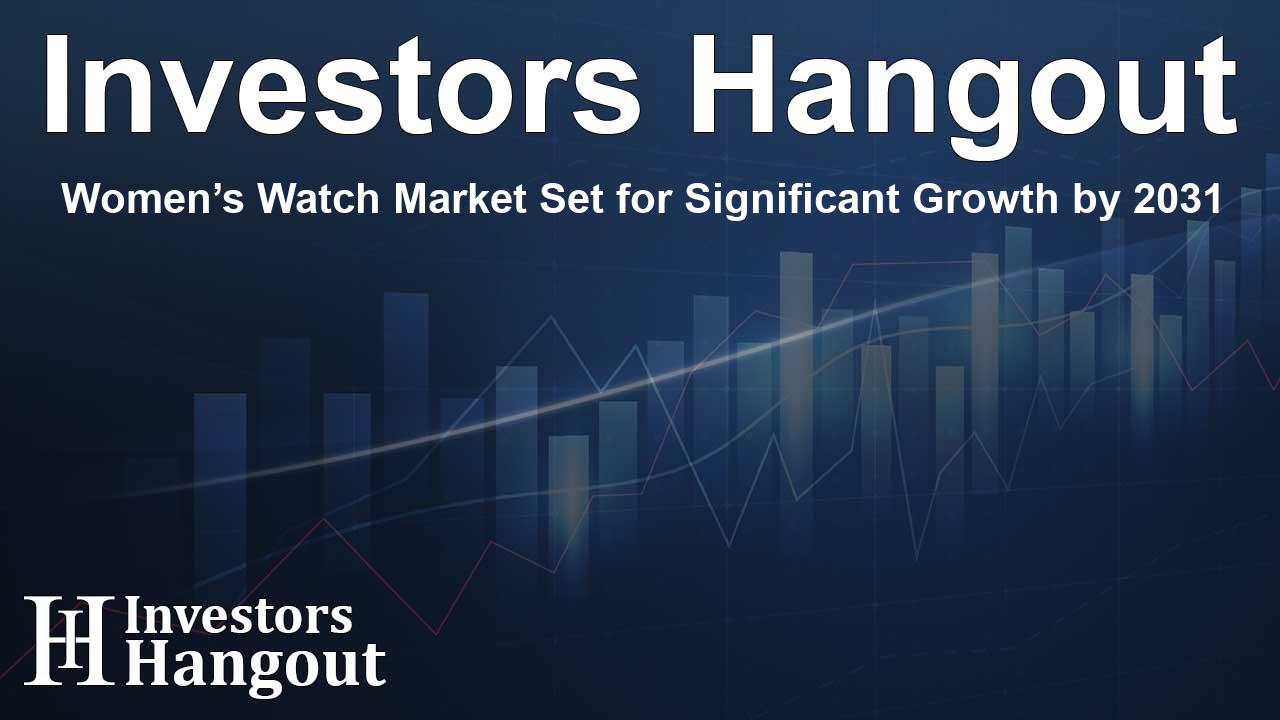Women’s Watch Market Set for Significant Growth by 2031

Women’s Watch Market Set for Significant Growth by 2031
The global women’s watch market is witnessing remarkable expansion, with projections indicating a market size of USD 37,411.9 million by 2031, a significant leap from USD 20,890.6 million in 2021. This growth can be attributed to evolving consumer preferences, heightened health awareness, and technological innovations in smartwatches.
Market Dynamics and Trends
Recent assessments reveal that the women’s watch market achieved revenues of USD 20,262.5 million in 2020, enjoying a year-on-year growth rate of 3.1% in 2021. As women increasingly regard watches not only as functional accessories but as essential fashion statements, the demand for versatile and high-quality designs continues to escalate.
Key Market Segmentation
The market segmentation encompasses product type, price range, and distribution channels, allowing businesses to dive deeper into consumer preferences. Companies that adapt their offerings based on these insights will likely gain a competitive edge and better serve the demands of their customers.
Innovations and Consumer Awareness
The demand for elegant and high-quality accessories that serve functional purposes is on the rise. The evolution of designs, materials, and multi-functional capabilities in watch manufacturing reflects this change. Additionally, the rise of smartwatches, catering primarily to tech-savvy consumers, is reshaping the landscape. These smart devices not only monitor health metrics but also connect users seamlessly to their networks.
Drivers of Growth in the Women’s Watch Market
Technological Advancements
One of the primary growth factors for this market is the increasing demand for smartwatches, particularly among women. Features such as heart rate monitoring, GPS connectivity, and fitness tracking are driving a wave of interest in multifunctional, stylish watches.
Health Consciousness
There’s a growing focus on health and wellness, with women looking for devices that can track physical activity, sleep, and overall health. This shift has led to a rise in investment in products that align with these health metrics.
Sustainability Trends
As ecological concerns rise, consumers are driving the demand for watches made from eco-friendly materials and using sustainable production practices. Additionally, personalized and bespoke designs are gaining traction, appealing to women seeking unique ways to express their individuality.
Regional Insights
Market Analysis in the United States
In the United States, the demand for smartwatches among tech-savvy women is soaring, with established companies expanding their offerings to meet this increasing need.
Canadian Market Dynamics
Similarly, in Canada, young women are increasingly adopting smartwatches, inspired by innovative products tailored to their lifestyle.
European Adoption Trends
Across Europe, women are leaning toward smartwatches for health monitoring purposes, with stronger disposable incomes facilitating this trend.
Competitive Landscape Overview
The competitive environment in the women’s watch market consists of a blend of established brands and innovative newcomers. Leaders such as The Swatch Group Ltd, Daniel Wellington, Apple Inc., and Helios are inciting competition based on design innovation, quality, and brand reputation, enhancing the shopping experience for women nationwide.
Fashion and Lifestyle Appeal
Watches daily cater to the aesthetic values of women, establishing their role not merely as time-telling devices but as vital fashion accessories.
Challenges Within the Market
Despite the growth prospects, challenges abound, including intense competition, counterfeit products, price sensitivity, and rapidly shifting consumer preferences. These factors force brands to be adaptive and innovative in their strategies moving forward.
Conclusion
The outlook for the women’s watch market is optimistic, with smartwatches and personalized designs driving demand. Companies that recognize and adapt to changing consumer preferences will ultimately lead the way in this evolving landscape.
Frequently Asked Questions
What is the projected market size for women’s watches by 2031?
The global women’s watch market is expected to reach USD 37,411.9 million by 2031.
What factors are driving the growth of the women’s watch market?
Key drivers include technological advancements in smartwatches, health consciousness among women, and increasing demand for sustainable products.
Which region is leading in the adoption of smartwatches among women?
The United States is currently leading in the demand for smartwatches, particularly among tech-savvy women.
Are personalized watches becoming popular?
Yes, there is a rising trend for personalized and bespoke designs in watches, allowing women to express their individuality.
What challenges does the women’s watch market face?
The market faces challenges such as intense competition, counterfeit products, and rapidly changing consumer preferences.
About Investors Hangout
Investors Hangout is a leading online stock forum for financial discussion and learning, offering a wide range of free tools and resources. It draws in traders of all levels, who exchange market knowledge, investigate trading tactics, and keep an eye on industry developments in real time. Featuring financial articles, stock message boards, quotes, charts, company profiles, and live news updates. Through cooperative learning and a wealth of informational resources, it helps users from novices creating their first portfolios to experts honing their techniques. Join Investors Hangout today: https://investorshangout.com/
Disclaimer: The content of this article is solely for general informational purposes only; it does not represent legal, financial, or investment advice. Investors Hangout does not offer financial advice; the author is not a licensed financial advisor. Consult a qualified advisor before making any financial or investment decisions based on this article. The author's interpretation of publicly available data shapes the opinions presented here; as a result, they should not be taken as advice to purchase, sell, or hold any securities mentioned or any other investments. The author does not guarantee the accuracy, completeness, or timeliness of any material, providing it "as is." Information and market conditions may change; past performance is not indicative of future outcomes. If any of the material offered here is inaccurate, please contact us for corrections.